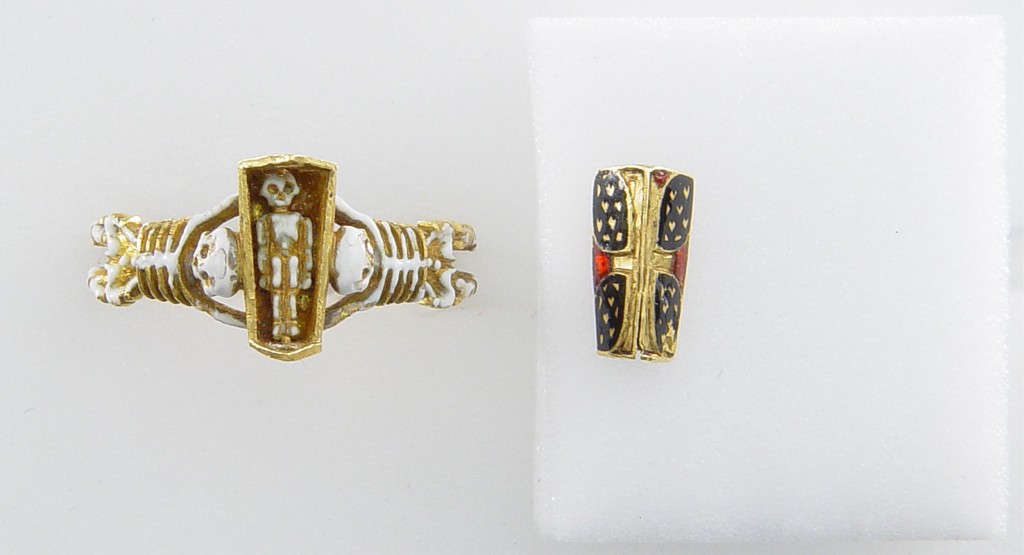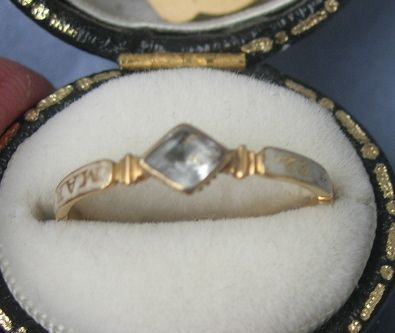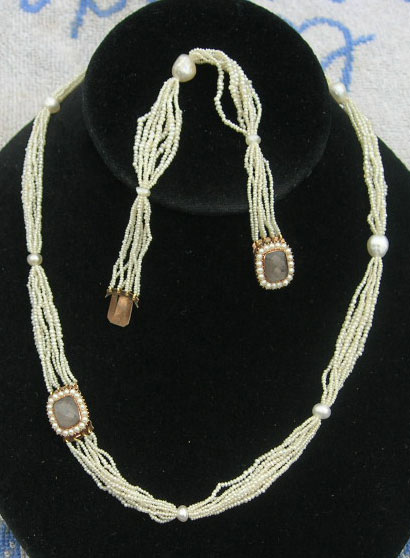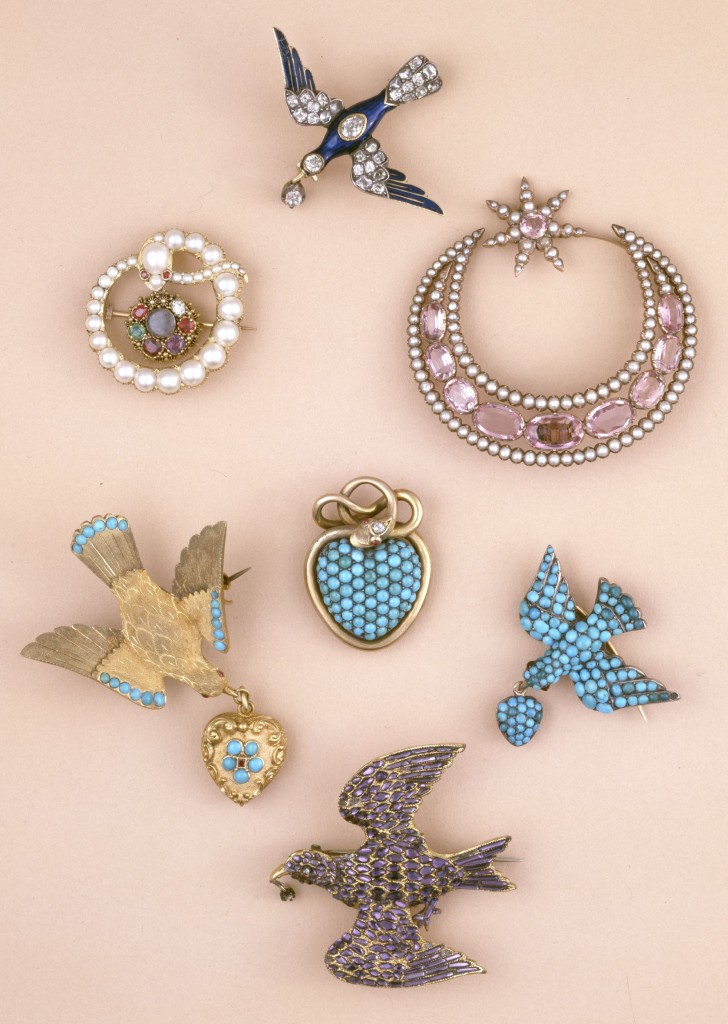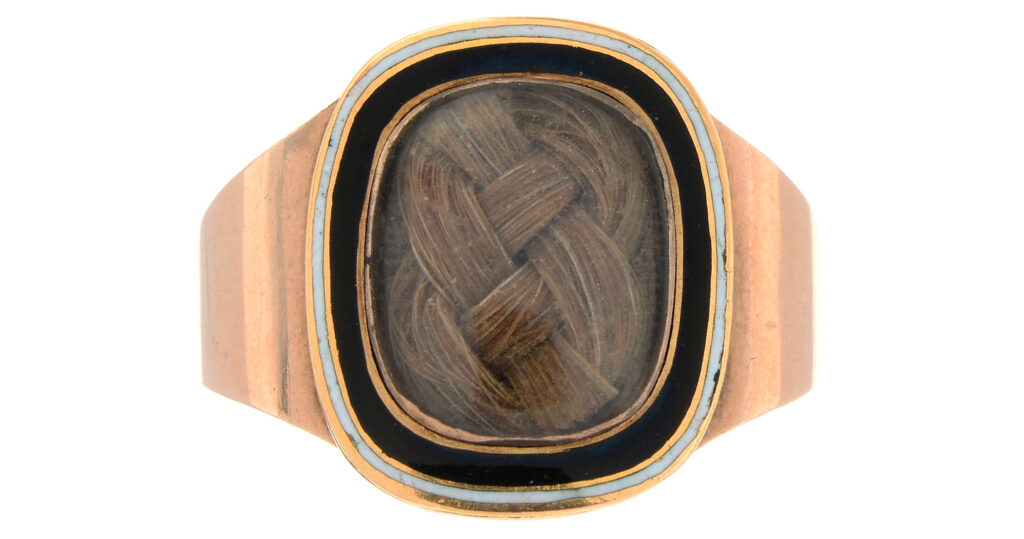Princess Amelia Mourning Ring, 1810
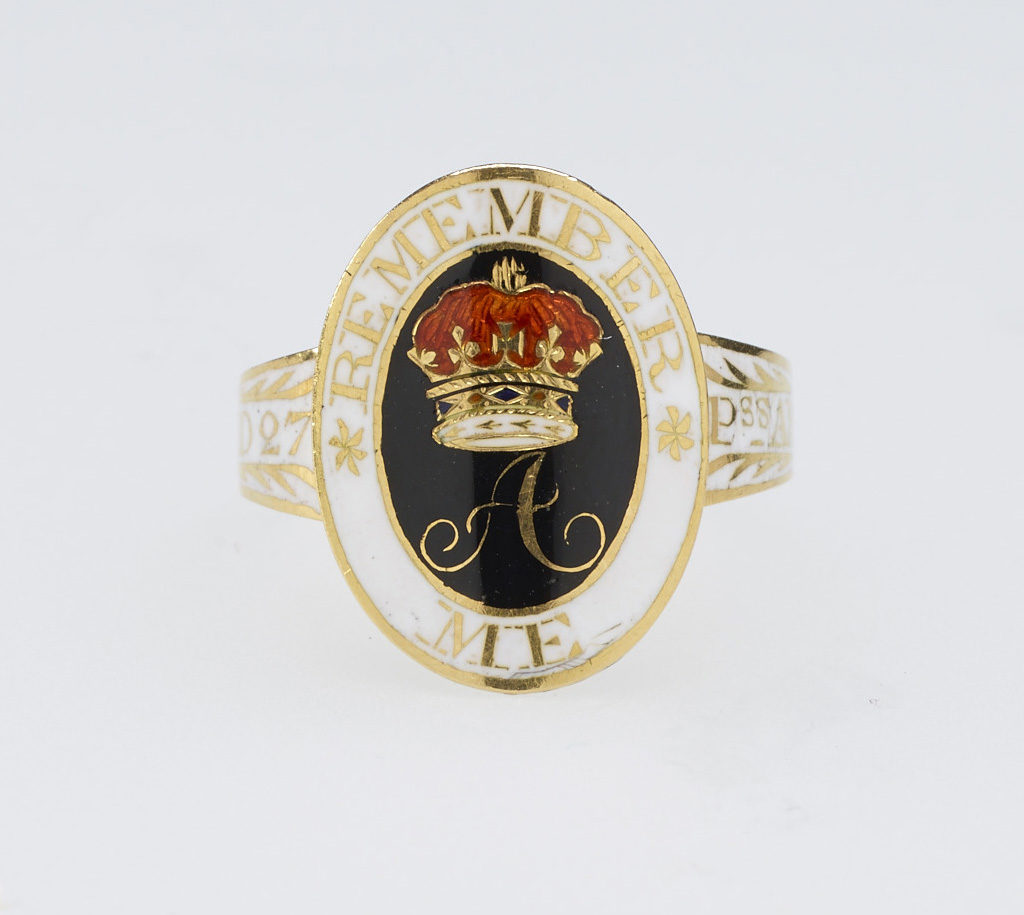
Fifty of these rings were ordered from Rundell & Bridge [and Rundell] at 58 shillings each. This ring was acquired by Queen Mary in 1935 and is currently part of the Royal Collection. I have written about a sister ring to this particular ring before, but it is important to see just how these rings were made and how they were given.
Royalty is often the best place to start when finding the most ideal jewel. All of the fashion, the culture and the experience of a society in Western culture is driven by the society who looks up to its leaders and interprets their lifestyle into theirs. The major difference in this is the cost of creating a jewel that can replicate the royal definition of what style is meant to be. This is the same today with modern production houses, whose designs are often copied or influenced in other jewels. Fashion and definition is the epitome of identity and value within a culture, as those who become a fashion can either make themselves part of a society or on its fringe. Jewellery helps much with this understanding, particularly in historical context. There isn’t much to separate today from the 19th or 18th centuries; our behaviours drive our needs and passions. If this is the case, the fact of mourning is the primary need for jewels of death, due to their immediate creation of an identity that society could perceive as mourning. For as long as culture has existed, this has not changed.
Princess Amelia (7th August 1783 – 2nd November 1810) was the youngest daughter of King George III of the United Kingdom and his queen consort Charlotte of Mecklenburg-Strelitz. George III’s family is one of the reportedly direct influences on his mental health that declined throughout his latter years. For an understanding of the average age of mortality of George III’s children, the following range of mortality is shown:
Prince Alfred (22 September 1780 – 20 August 1782; died aged 23 months)
Prince Octavius (23 February 1779 – 3 May 1783; died aged 4)
Princess Amelia (7 August 1783 – 2 November 1810; died aged 27)
Prince Edward, Duke of Kent and Strathearn (2 November 1767 – 23 January 1820; died aged 52)
Charlotte, Princess Royal (29 September 1766 – 6 October 1828; died aged 62)
Prince Frederick, Duke of York and Albany (16 August 1763 – 5 January 1827; died aged 63)
King George IV of the United Kingdom and Hanover (12 August 1762 – 26 June 1830; died aged 67)
Princess Elizabeth (22 May 1770 – 10 January 1840; died aged 69)
Princess Sophia (3 November 1777 – 27 May 1848; died aged 70)
King William IV of the United Kingdom and Hanover (21 August 1765 – 20 June 1837; died aged 71)
Princess Augusta Sophia (8 November 1768 – 22 September 1840; died aged 71)
Prince Adolphus, Duke of Cambridge (24 February 1774 – 8 July 1850; died aged 76)
King Ernest Augustus I of Hanover (5 June 1771 – 18 November 1851; died aged 80)
Prince Augustus Frederick, Duke of Sussex (27 January 1773 – 22 April 1843; died aged 80)
Princess Mary, Duchess of Gloucester and Edinburgh (25 April 1776 – 30 April 1857; died aged 81)
These aren’t chronological, but the order of age. Considering that George died on the 29th of January, 1820, this is enough to see four of his children pass away, with the youngest two boys said to have affected his mental health the most. What this shows is the behaviour of a father who loves his family and is at the mercy of his kingdom and its reach. During his reign, there was the loss of the American colonies, the French Revolution/Terror and the Napoleonic Wars; major events that could have led to mass destabilisation of Britain, and also a good indicator of what led to aggressive colonisation for global footprint.
![Portraits of their majesties, George III and Queen Charlotte, and the Royal Family visiting the Exhibition of the Royal Academy, 1788. Based on the same painting by Ramberg as Martini's engraving [E.3648-1923].](https://artofmourning.com/wp-content/uploads/2015/02/2013GU1794-1024x768.jpg)
Being a parent and outliving a child is one of the most unnatural of occurrences that can happen emotionally or biologically. Procreating, or the need to, is within biology, yet the emotion that is connected to it is inherent to the very nature of wanting to. George, being a father, loved his children. Certainly, there was the necessity of the monarchy to generate a lineage, but this should not devalue the individual as a father. Amelia’s death weighed heavily on the crown, even though he still had further family, George was highly affected by the death of his daughter.
“THE KING’S CONDITION SELECTS THE ANTHEM FUNERAL BY TORCHLIGHT ACCOUNT OF THE CEREMONY FEELING THROUGHOUT THE COUNTRY ELEGIES ON THE PRINCESS DEATH OF MARY ANNE GASKOIN HER EPITAPH.
IT was remarked by the King’s physicians that when he had become a prey to insanity the name of his daughter Amelia ceased to pass his lips. At first, however, he occasionally had fleeting intervals of comparative calm and reason. Four days before her death he was overheard holding a conversation with himself, the subject being the several causes of each of the mental illnesses from which he had suffered in past years. ” This” he said, speaking of his present malady, “was occasioned by poor Amelia.”” – The romance of Princess Amelia, daughter of George III (1783-1810) including extracts from private and unpublished papers
What is most affecting about Amelia’s death is the proximity of George to her and how this reflected in the fashion of her death. It wasn’t so simple as to have a ring produced for a person who had passed as a token of care, but this was a ring made from the very nature of love and grievance. Even in its very wording, “REMEMBER ME”, the ring speaks volumes of Amelia under the crown. It is a direct message from the wearer to the viewer to remember Amelia and that is the true aspect of how her death affected the people surrounding the crown. More so, these rings were created in a set of 52. Commissioned by the Prince Regent, later George IV, to mark her life, her brother marked her memory in a way of respect and entitlement that goes beyond formality.
The white enamel in the jewel is a mark of respect that denotes a lady whom has not been married before death. White enamel is the second most popular mourning material used, next to black enamel. Black enamel, being a colour that has represented death through to pre-history, was (and still is), the colour that was inlaid in jewels, most commonly with the ‘IN MEMORY OF’ sentiment. This was highly standardised by the 19th century, but in the 18th, there was much more flexibility with the use of sentiment and enamel colour.
What was common was the white enamel. Death, for its reasons of desecration and entrance into entropy, lead towards black, which in itself, is the absence of light. White, when in use, is the connection to purity, innocence and virginity, show the untarnished representation in colour towards a person’s morals and values. A young person who was not married was seen as unblemished in social status and the use of the white enamel to show this virtue is why white enamel is used in this context.
This ring shows nothing more than the sentiment of the person in the value of the name, which is extraordinary, when connected to jewels that show the name with a sentiment on the interior or exterior. White enamel, being more of a bespoke material, is something which can be seen as a personalised element in rings and bands. This ring shows that the style was indoctrinated through the following bands:
By the 1730s, we see the elements of white enamel and the band together. The use of the name and the date denote the death of the unmarried, and hence “pure” person was memorialised through the basic band in the white decoration.
In 1740, the combination of Memento Mori and the Rococo style had created a fashion of opulent design and factual death. Under crystal, the skull and death motifs were common, while the decorated ‘ribbon’ band was typical of the Rococo style.
When the Neoclassical movement was in its height, the allegorical depictions still retained the style of the previous bands. White enamel decorated rings with the name of the subject who had passed on, with the bezel now showing the typical sentimental images of the urn, weeping woman and willow.

Past the Neoclassical period, the streamlined geometric styles that were popular in the Regency era had shown a cleaner design to the band, with the focus on font and a singular element being the most prominent element to the jewel itself.

Amelia’s ring shares many of the common elements as the above ring from 1810. The shape of the wide band conforming around the bezel and the rectangular hair compartment under glass evolve the style of the oval that was common previously.
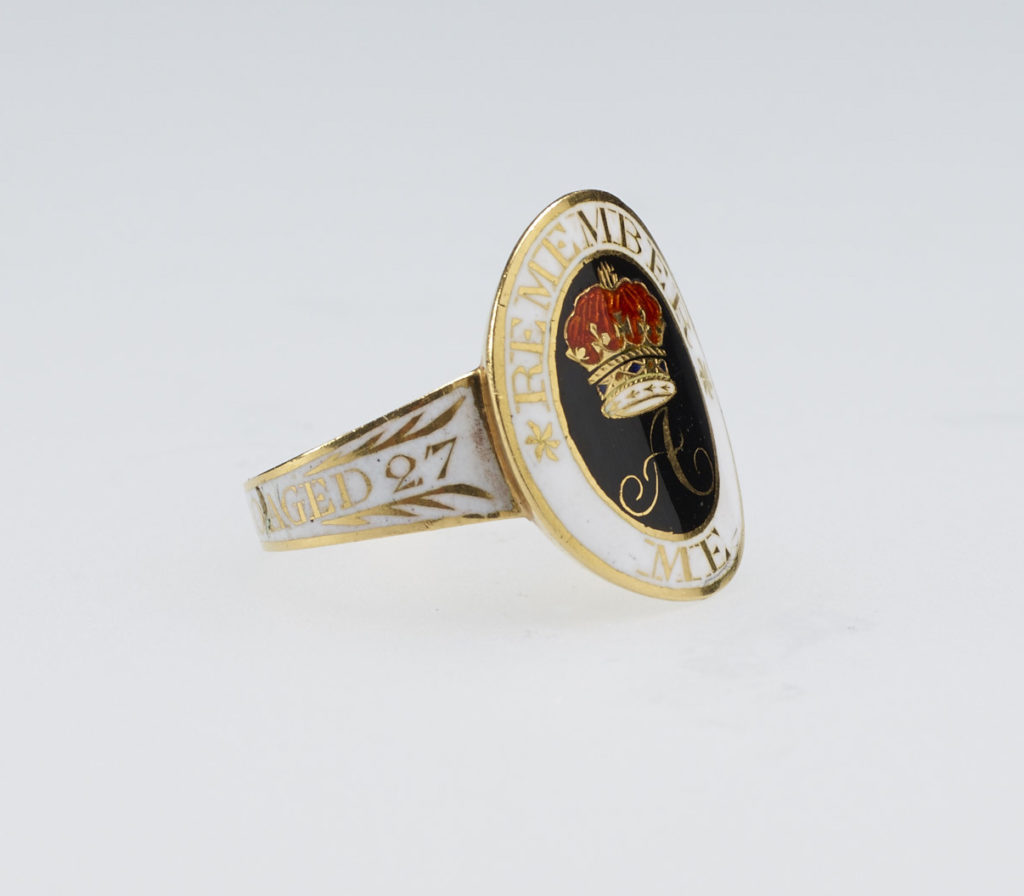
In Amelia’s ring, we may simply have a white enamelled ring, but the fashion and circumstance around her death can be also explained through primary sources of the time. The ring was made by the Royal goldsmiths, Rundell, Bridge & Rundell, making it a leader in style and fashion, the template for what others would emulate. Often, the jewels of death are removed from their even. What we have are the remnants of memory, rather than how they integrated into the lifestyles of those who were given, or those who had worn, them. Mourning is personal, regardless of what the custom states in history, so it is more interesting to find out just how mourning entered the lives of those who indoctrinated the practice.
Even before the moment of Amelia’s passing, the sentiment was:
“Lady Ailesbury, writing to Lady Louisa Stuart in August 1810, says that “every one in Bath had bought their mourning,” believing that Princess Amelia could not recover.”
To ‘bring mourning’ establishes that it was customary to be present in the proper attire of mourning for the subject before even the death is announced. Even still, the time of communications in the early 19th century must be understood, it is not so simple for a person to change their clothing depending on an immediate happening just because it is convenient. Costume must be planned, for its very creation could take time. Amelia’s ailments would need to be considered before entering a place of society and presenting oneself in it. At the time, a disease or injury would factor closer to death rather than a positive outcome, so it makes sense that mourning was being prepared in advance.
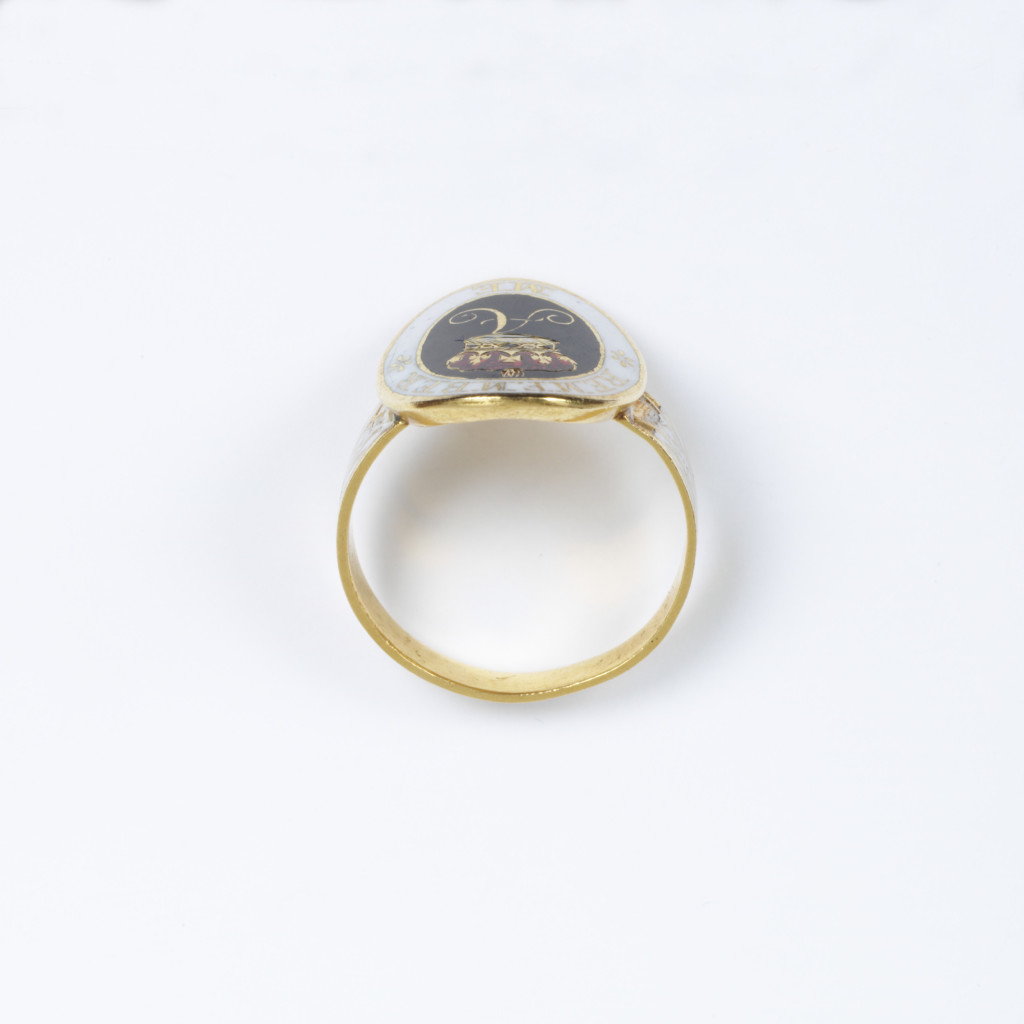
To deal the public mourning, the following happenings occurred:
“In consequence of a delay in sending an official notice of her Royal Highness’s death to the Dean of St. Paul’s, caused by the death of the Lord Chamberlain Lord Dartmouth, the custom of tolling the great bell at St. Paul’s did not take place till Sunday afternoon, November 4, immediately after a grand funeral anthem had been sung.” Gentleman’s Magazine for November 1810.
From November 5 orders were issued for a general mourning, and theatres and all other places of public amusement were closed till after the funeral (the 14th).” – The romance of Princess Amelia, daughter of George III (1783-1810) including extracts from private and unpublished papers
Mourning was not ordered until the 5th of November, three days after the death of Amelia and the Monday following the funeral. This general mourning period affected those at court and also cascaded down into society.
“But with all the pomp and paraphernalia of mourning the real chief-mourner was absent. There was no rightful place for the man who loved the dead Princess, who was betrothed to her, and whose bereavement far exceeded that of any of those who were bidden to make a show of grief. General Fitzroy is reported to have been ill, and it may well have been that he was so. He bore his sorrow in silence and alone, while the doleful pageant was being enacted in which he had no part.” – The romance of Princess Amelia, daughter of George III (1783-1810) including extracts from private and unpublished papers
What is clear from those who were close to Amelia and her death is that it was indeed a personal affair. George’s grief is clear in all texts and so is the silence that had befallen those who surrounded him. Mourning becomes not an ephemeral thing, but something that is an emotion. Grief and fashion are clearly two different things. While this ring may symbolise a style of jewellery that was contemporary and popular for its fashion, its grief is flowing through the fingers of its wearers.
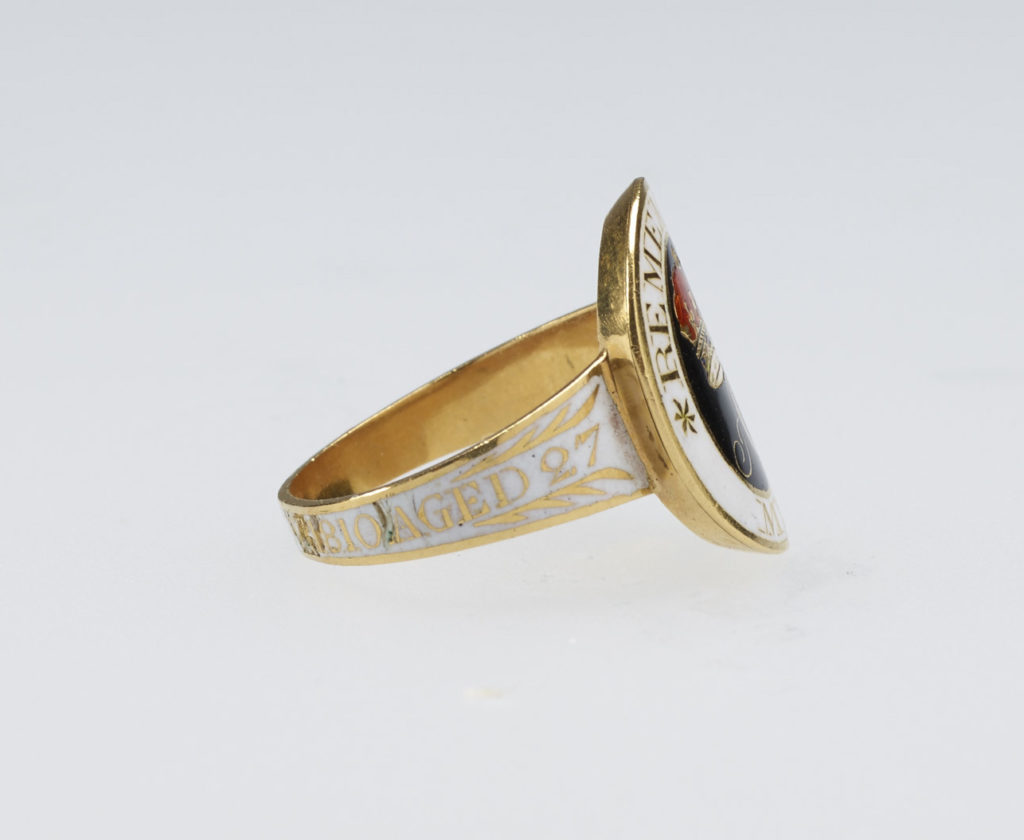
Yet mourning is not simply the element that comes from death, but the moments of the immediate passing. Once there was life and then there is the unfortunate eventuality of the moment, mourning begins. In the case of Amelia, this was a custom and moved the idea of mortality closer to the home than a contemporary audience would normally allow:
“No proper state was kept up only 1 pair of candles two sofas made up as beds no refreshments prepared. Two maids sat up with the body. No pages or men-servants sat up, only women about the house. The duty was over at 8, and we left Windsor at half-past nine. The funeral is on Tuesday next. Lady A. C. as senior lady is to walk alone. All the ladies in long white crape veils and gloves. The men in dress coats…
“Princess A. gave a ring to… M[ontmolin] two days before her death. [The King] had been much distressed she gave nothing to the Q. It really made him miserable. When Miss Knight in her Autobiography says, “Two ladies sat up with the corpse every night until the time of the funeral. I was directed to perform this duty with Lady George Murray. We were in a room adjoining that in which was the coffin with the doors open. On the table was a book which had been a favourite with Princess Amelia. It was Tilikeper’s Thoughts on Religious Subjects, and many of them had a pencil mark.”
An extraordinary number of ornamental nails were put on the coffin of Princess Amelia.”
Insights into mourning fashion of the time can be seen in what is written about the ‘ladies in long white crape veils and gloves’ – this is the standard of the time. What modern perceptions of mourning and sentimental ritual began primarily in the 1840s, yet in the 1810s, there was a lot of movement about how fashion and identity were perceived.
With an understanding of the funeral and circumstance surrounding Amelia’s death and the writes of her funeral, it is important to look into the late 18th and early 19th centuries and how fashion and politics created an outcome that could establish such an event.
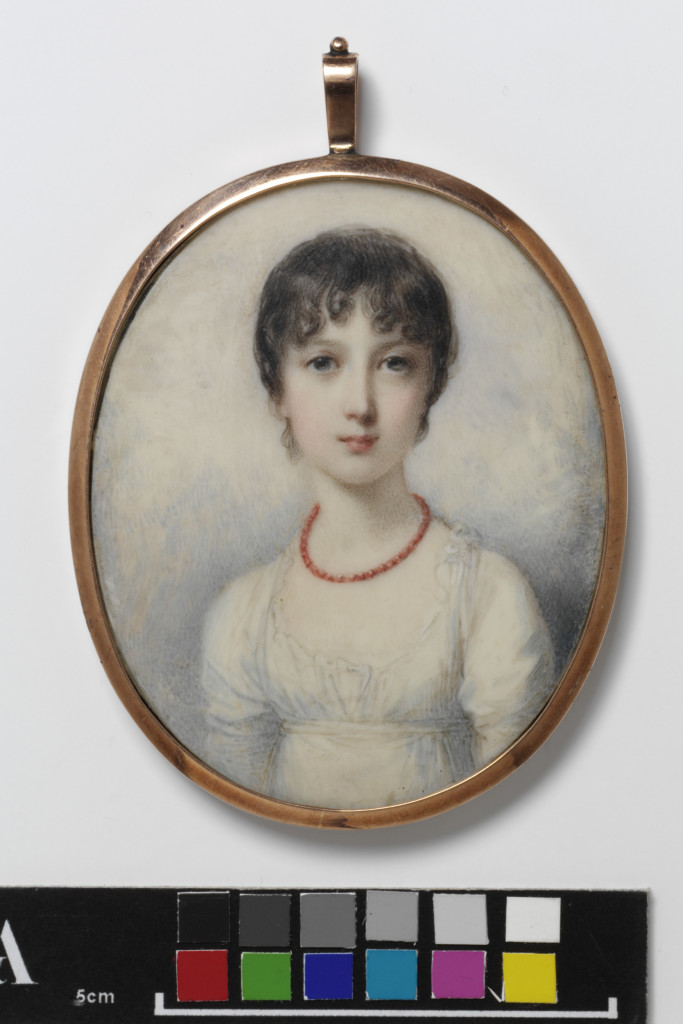
The 18th century welcomed in greater convention for mourning fashion and began to see the rise of the mourning industry. This became so much so that mourning dress was becoming desirable and the difference between mourning and non mourning dress was narrowing. Much of the fashion in this century was dictated by the fabric rather than the cut, and the silk industries in France and England held major influence on mourning wear because of this. It was Ordre Chronologique des Deuils de la Cour, (1765) where details of Court mourning in France were published, giving precise tailoring instructions. From their first days in mourning, men were permitted to appear in Court, unless it was after the death of a parent from whom they had received inheritance.
“‘dress was cut with a train and turned back with a braid attached to the side of the skirt, which was pulled through the pockets.’ This is where the overskirt is turned to the back and lifted up, revealing the petticoat underneath, called; robe retrousee dans les poche, the centre front robings were joined with hooks or ribbons. Cuffs were cut with one fold and deep hems, the waist was held in place by a crape belt that was tied on. This left two ends hanging down to the hem of the skirt. A woman’s accessories were a crape shawl, gloves, shoes with metallic bronzed buckles, a black woollen muff and a black crape fan. Head dresses of black crape and white batiste were referenced. For much of the century, however, ‘paniers’ were fashionable, but in the French style, with loose pleating falling from the shoulders to the back. The English manner of this was with the back pleats stitched down as far as the waistline. Also popular were lace ruffles at the neck and the cuff, embroidered stomachers, silver gilt lace, appliqué work and small aprons. None of these were permitted for mourning wear. Mourning wear for women still remained consistent in that it remained plain, black or sometimes white fabric” – Ordre Chronologique des Deuils de la Cour, (1765)
Widows had to wait one year and six weeks, with the first six months in black wool. Lord Chamberlain and Earl Marshall both ordered shorter periods of mourning in France and England respectively. By the 1880s in Britain, twelve weeks of mourning were ordered by the death of a king or queen, six weeks after the death of a son or daughter of the sovereign, three weeks for the monarch’s brother or sister, two weeks for royal nephews, uncles, nieces or aunts and ten days for the first cousins of the royal family. Foreign sovereigns were mourned for three weeks and their relatives for a shorter time. Mourning was divided up into First, Second and Court mourning.
Though there had been growing small scale social mobility from the late 17th century, the late 18th and early 19th centuries saw the middle classes having the opportunity to promote through society with the accumulation of wealth. Augustus Welby Northmore Pugin, a designer, architect and convert to Catholicism, saw this Industrial Revolution as a corruption of the ideal medieval society. Through this, he used Gothic architecture as a way to combat classicism and the industrialisation of society, with Gothic architecture reflecting proper Christian values. Ideologically, Neoclassicism was adopted by liberalism; this reflecting the self, the pursuit of knowledge and the freedom of the monotheistic ecclesiastical system that had controlled Western society throughout the medieval period. Consider that Neoclassicism influenced thought during the same period as the American and French revolutions and it isn’t hard to see the parallels.
In 1789, the French Revolution affected jewellery wearing and production to a great extent. The First French Empire under Napoleon retained and grew the popular Neoclassical styled jewels, maintaining their position as the primary leaders of fashion. Even with the hostilities between 1793-1815, the English closely followed Parisian styles.
By its very nature of wealth, jewellery was seen as a status symbol in France; an identifier for aristocratic status. During the Terror, the very possession of jewels or belt buckles may be enough to condemn one to the guillotine, while those who gave their jewels to the cause were seen as supporters and others simply hid theirs away for financial security if fleeing the country.
Jewels that were sold off following the Terror flooded the European market and dropped the prices of gems. In Paris, the only jewels to remain popular were souvenirs of the Terror itself. Simple iron relics inscribed with commemorations about the storming of the Bastille, or pieces containing stone or metal from the Bastille. Jewellery, by essence is a token. A reminder for memory to signify a time or a relationship in time that others can identify you by. When a culture suffers such a dramatic change, the utilisation of jewellery to promote a political message is not only important for the person’s connection to a community, but for their very safety itself.
In 1797, the Paris Company of Goldsmiths was reinstated, after being abolished in 1791, reintroducing many of the goldsmiths from the reign of Louis XVI. By 1798, hallmarking was established in France, making it compulsory to stamp jewels under three standards of purity; 750, 840 and 920 parts per 1000. They were also stamped with a maker’s mark (the maker’s or sponsor’s initial) and symbol in a lozenge-shaped stamp.
Filigree jewellery and fine detail to gold work had its inception here, as there was as shortage of money and goldsmiths became inspired by French peasant jewellery to produce finely detailed gold with lesser materials. Seed pearls, basic gems (such as agates) were also popular, as can be seen in the following pieces:
In the above, we can see how the fashion of fine gold and the access to seed pearls from the Orient made for highly detailed and inexpensive jewellery. Large enough to be seen and influenced by the Neoclassical style, this was a society adapting to the hardships that they were surrounded by.
This ring is the product of the use and popularity of the carnelian in jewellery. As these elements become popular, they resonate throughout society and here we see it with the intaglio inscription of ‘pietas’ in a swivel ring.
In 1804, the Napoleon’s Empire was announced and luxury trades were renewed with vigour. Bijoutiers, who worked in ordinary materials and joailliers, who worked in precious stones benefitted from this rise in luxury, with Napoleon requesting the jewels from the former kings of France to be set in the Neoclassical style, essentially connecting him to the Greco-Roman empires. His coronation crown was decorated with cameos and his passions for the antique world led him to establish a school of gem engraving in 1805. If ever there was a height for the Neoclassical period, it was this connection to it. How other societies would reflect this moment is seen in their contention or support of Napoleon. Here is a person who is appropriating the classical world in a time where it had been in mainstream thought and fashion for around forty years. International tension would only lead to the decline of this style, as cultures needed to obtain their own identities in jewellery fashion. A great push to the Gothic Revival style in England has its roots in this.
Simple designs and smaller jewels following in this early 19th century period. The geometric shapes, ovals, circles and rectangles became popular, with the Greek key pattern utilised often in jewels. It was about balance, with many patterns being taken directly from Greco-Roman architecture and detail. During this time, until his remarriage, Josephine was the bastion of style, maintaining the fashion which people would covet.
From this, what we see is that society had to adapt to the shock of the Terror and the new Empire, all the while other cultures are looking to France for its style and reestablishment. Greater and more literal influences of antique cultures led to the allegory of the sentimental depictions becoming literal interpretations of their architecture in jewels, making the individual the monument to classical art itself.
It cannot be understated how important the French influence upon sentimental jewels was in the turn of the 19th century. From the souvenir jewels stating such terms as “Souvenir d’amitié” and “Souvenir d’armour”, the statements of love that were worn on display created a new social proprietary that involved the use of sentimental jewels to offer admired people, within social circles, as signs of courtship and love.
Much of this sentiment stemmed from the French Revolution and its cultural challenge to established monarchy and religious value systems, particularly in the form of Liberté, égalité, fraternité (liberty, equality and fraternity). While the French Restoration of the first-quarter 19th century had repaired the monarchy itself, the challenge to established order had accomplished a lot to put new values in relationships and empower individuals. George IV encouraged society to look externally for artistic influence, since his ascendancy (and Regency, post Regency Act of 1811), George’s investment in the arts was required for the aristocracy to have these tokens of love as social requirements above simple affectations.
The Bourbons were restored in 1814, with jewels being more sedate in their designs due to the lack of wealth. Threaded seed pearl on horse hair created ornate bracelets and necklaces, with materials being smaller and more abundant to exaggerate their use. During the 1820s and 1830s, the use of cannetille (surface covered with wire) or grainti (small granules) embellished the colour of gemstones, as the gold was used in the base of the jewel. As seen with the portrait of Lady Peel by Sir Thomas Lawrence above, the wearing of several bracelets and enamelled rings on one finger elaborately exaggerated the colour of the jewellery. Classical style was starting to become overcome with elements of the Baroque and Rococo, which had only been popular previous to the Neoclassical period.
How this affected the mind of the early 19th century individual was a direct stylistic move away from what had bought about the unrest of the Neoclassical style. With competing styles being mixed for mainstream appeal, the classical style in its literal form would recede until the mid 19th century and the archaeological discoveries that would ignite it once more, such as Etruscan.
In the early 19th century, there was much to define the self through the identity of jewels. Neoclassical allegory had put the focus back upon the elements of the natural world which could contain their own symbolism. In the above image, the REGARD jewel is seen within the coiled serpent, denoting eternal love and piety. Given as a keepsake for a betrothed, all of the above jewels have a sentimental resonance, denoting futurity and an offering of new life and love.

Amelia lived and died at a time of modern social definition. Many of the elements that were taken from this time were indoctrinated by the Victorians and a lot of the industry, politics and values are still established today. From this article, we began with the basic nature of the ring and its design, then looked at the death of Amelia, which is what produced this ring. From a social perspective, we looked at the rest of the world and how a ring like this could be produced and identified as a mourning ring.
Jewels should never be taken for granted, they house the memory and love of an entire life. It is easy to generalise and conform a jewel to what a modern perception of it could be, or just take it for the basic value of being a simple metal token. From this ring we understand some of her values and those of her family and friends and that brings us one step closer to experiencing history.




